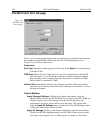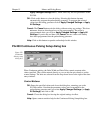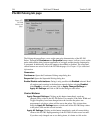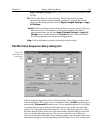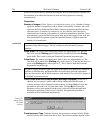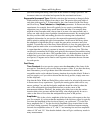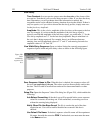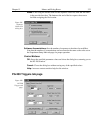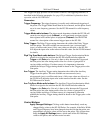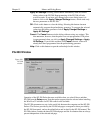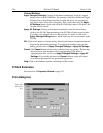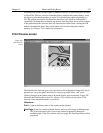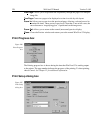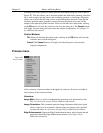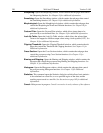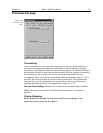
324 WinView/32 Manual Version 2.4.M
The Triggers tab page provides for user control of the PG-200 triggering functions, as
described in the following paragraphs. See page 325 for additional information about
operation with the PG-200 Pulser.
Parameters
Trigger Frequency:
The trigger frequency is usually used with internal triggering of
the pulser. The Trigger Mode should then be set to Internal, and the pulser would
act as its own frequency generator. See the PG-200 manual for valid frequency
values.
Trigger Mode radio buttons:
The trigger mode determines whether the PG-200 will
create its own trigger signals (
Internal
), or will gate based on trigger signals
that originate in an external piece of equipment (
External
). See the PG-200
manual for a description of the external trigger input on the PG-200.
Delay Trigger:
The Delay Trigger setting determines the width of the Delay Trigger
from the pulser. The units available are nanoseconds (nsec), microseconds
(µsec), or milliseconds (msec). Only some values are allowed, so the PG-200
will adjust the input value to the nearest allowable value. See the PG-200 manual
for details.
Dlyd Trig Sync Mode radio buttons:
The Delayed Trigger Synchronization Mode
allows for a signal to be sent from the PG-200 a fixed time after either the
Trigger
or the
Gate
pulse. Not only is there a delay between the Trigger and
the Gate pulse, but some timing modes allow for a series of gate pulses of
varying widths and delays. For these reasons it is important to determine
whether the Delayed Trigger timing should be based on the Trigger pulse or the
Gate pulse.
Aux Trigger:
The Auxiliary Trigger setting determines the width of the Auxiliary
Trigger from the pulser. The units available are nanoseconds (nsec),
microseconds (µsec), or milliseconds (msec). Only some values are allowed, so
the PG-200 will adjust the input value to the nearest allowable value. See the
PG-200 manual for details.
Aux Trig Sync Mode radio buttons:
The Auxiliary Trigger Synchronization Mode
allows for a signal to be sent from the PG-200 a fixed time after either the
Trigger
or the
Gate
pulse. Not only is there a delay between the Trigger and
the Gate pulse, but some timing modes allow for a series of gate pulses of
varying widths and delays. For these reasons it is important to determine
whether the Auxiliary Trigger timing should be based on the Trigger pulse or the
Gate pulse.
Control Buttons:
Apply Changed Settings:
Clicking on this button immediately sends any
changed dialog values to the PG-200 Pulser. For example, if the Pulse Width
and Trigger Frequency have been changed since the last time the pulser was
programmed, only those values will be sent to the pulser. This is faster than
using the
Apply All Settings
button, which sends all the PG-200 Setup
values to the pulser, and can take several seconds.



